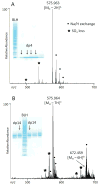High-resolution preparative separation of glycosaminoglycan oligosaccharides by polyacrylamide gel electrophoresis
- PMID: 20211145
- PMCID: PMC2860026
- DOI: 10.1016/j.ab.2010.03.004
High-resolution preparative separation of glycosaminoglycan oligosaccharides by polyacrylamide gel electrophoresis
Abstract
Separation of milligram amounts of heparin oligosaccharides ranging in degree of polymerization from 4 to 32 is achieved within 6h using continuous elution polyacrylamide gel electrophoresis (CE-PAGE) on commercially available equipment. The purity and structural integrity of CE-PAGE-separated oligosaccharides are confirmed by strong anion exchange high-pressure liquid chromatography, electrospray ionization Fourier transform mass spectrometry, and two-dimensional nuclear magnetic resonance spectroscopy. The described method is straightforward and time-efficient, affording size-homogeneous oligosaccharides that can be used in sequencing, protein binding, and other structure-function relationship studies.
Copyright (c) 2010 Elsevier Inc. All rights reserved.
Conflict of interest statement
None declared
Figures




Similar articles
-
Preparation and structural characterization of large heparin-derived oligosaccharides.Glycobiology. 1995 Feb;5(1):83-95. doi: 10.1093/glycob/5.1.83. Glycobiology. 1995. PMID: 7772871
-
Fractionation of heparin-derived oligosaccharides by gradient polyacrylamide-gel electrophoresis.Biochem J. 1987 Jun 15;244(3):515-22. doi: 10.1042/bj2440515. Biochem J. 1987. PMID: 3446173 Free PMC article.
-
Isolation and recovery of acidic oligosaccharides from polyacrylamide gels by semi-dry electrotransfer.Electrophoresis. 1990 Jan;11(1):23-8. doi: 10.1002/elps.1150110106. Electrophoresis. 1990. PMID: 1690641
-
Forced degradation and impurity profiling: recent trends in analytical perspectives.J Pharm Biomed Anal. 2013 Dec;86:11-35. doi: 10.1016/j.jpba.2013.07.013. Epub 2013 Jul 31. J Pharm Biomed Anal. 2013. PMID: 23969330 Review.
-
Ion chromatography for the separation of heparin and structurally related glycoaminoglycans: A review.J Sep Sci. 2016 Mar;39(6):1118-29. doi: 10.1002/jssc.201500664. Epub 2016 Feb 29. J Sep Sci. 2016. PMID: 26800335 Review.
Cited by
-
Electrospray ionization Fourier transform mass spectrometric analysis of intact bikunin glycosaminoglycan from normal human plasma.Int J Mass Spectrom. 2011 Aug 15;305(2-3):109-115. doi: 10.1016/j.ijms.2010.09.020. Int J Mass Spectrom. 2011. PMID: 21860600 Free PMC article.
-
Analysis of E. coli K5 capsular polysaccharide heparosan.Anal Bioanal Chem. 2011 Jan;399(2):737-45. doi: 10.1007/s00216-010-3679-7. Epub 2010 Apr 21. Anal Bioanal Chem. 2011. PMID: 20407891 Free PMC article.
-
Top-down approach for the direct characterization of low molecular weight heparins using LC-FT-MS.Anal Chem. 2012 Oct 16;84(20):8822-9. doi: 10.1021/ac302232c. Epub 2012 Sep 26. Anal Chem. 2012. PMID: 22985071 Free PMC article.
-
Isolation of bovine corneal keratan sulfate and its growth factor and morphogen binding.FEBS J. 2013 May;280(10):2285-93. doi: 10.1111/febs.12165. Epub 2013 Feb 28. FEBS J. 2013. PMID: 23402351 Free PMC article.
-
Sequence analysis and domain motifs in the porcine skin decorin glycosaminoglycan chain.J Biol Chem. 2013 Mar 29;288(13):9226-37. doi: 10.1074/jbc.M112.437236. Epub 2013 Feb 19. J Biol Chem. 2013. PMID: 23423381 Free PMC article.
References
-
- Capila I, Linhardt RJ. Heparin-protein interactions. Angew Chem Int Ed Engl. 2002;41:391–412. - PubMed
-
- Korir AK, Larive CK. Advances in the separation, sensitive detection, and characterization of heparin and heparan sulfate. Anal Bioanal Chem. 2009;393:155–69. - PubMed
-
- Rice KG, Kim YS, Grant AC, Merchant ZM, Linhardt RJ. High-performance liquid chromatographic separation of heparin-derived oligosaccharides. Anal Biochem. 1985;150:325–31. - PubMed
-
- Skidmore M, Atrih A, Yates E, Turnbull JE. Labelling heparan sulphate saccharides with chromophore, fluorescence and mass tags for HPLC and MS separations. In: Packer NH, Karlsson NG, editors. Methods in molecular biology. Humana Press; 2009. pp. 157–69. - PubMed
Publication types
MeSH terms
Substances
Grants and funding
LinkOut - more resources
Full Text Sources
Medical

